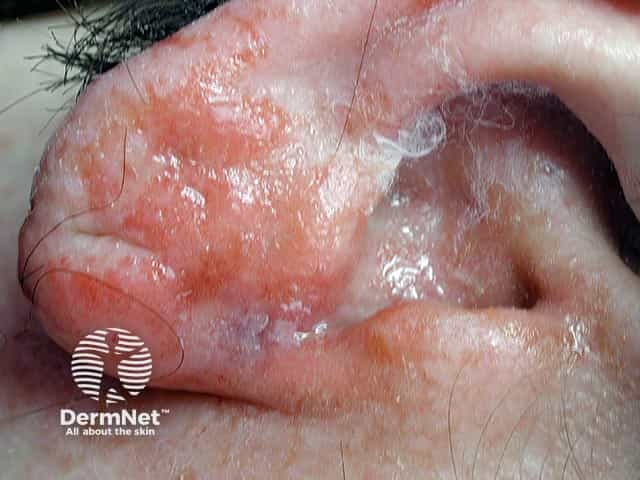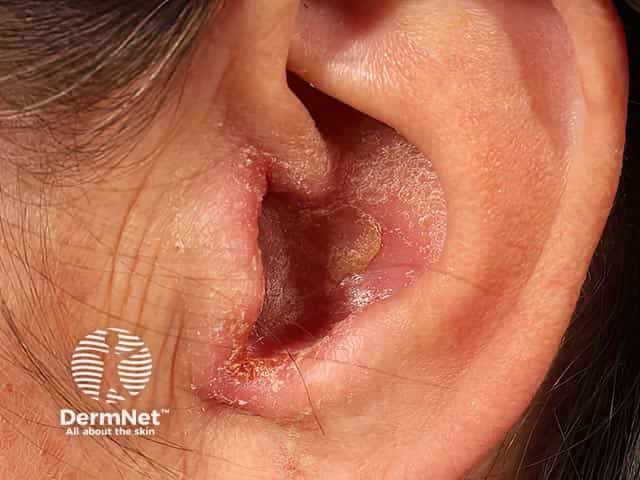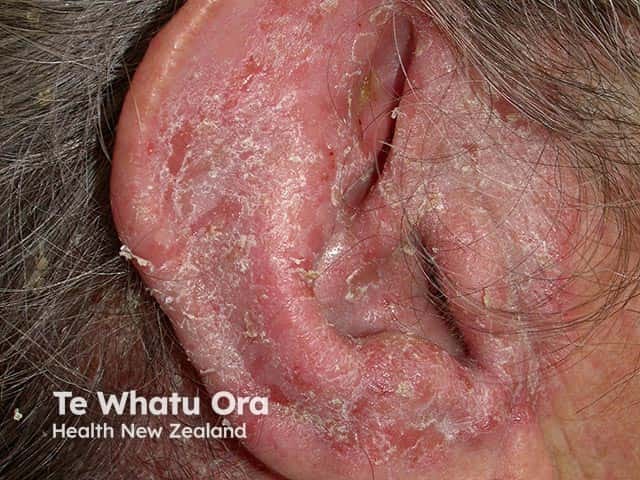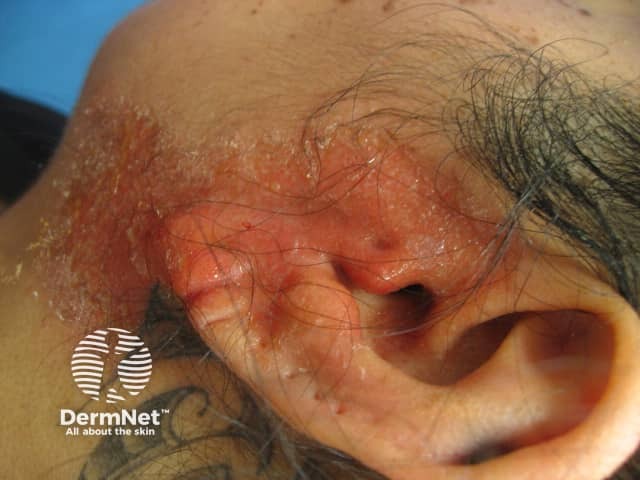Main menu
Common skin conditions

NEWS
Join DermNet PRO
Read more
Quick links
Otitis externa — extra information
Otitis externa
Last Reviewed: February, 2024
Author: Dr Ha Eun Grace Kim, Advanced Trainee in General Medicine, North Shore Hospital, New Zealand (2024)
Previous contributors: Vanessa Ngan, Staff Writer (2005)
Reviewing dermatologist: Dr Ian Coulson
Edited by the DermNet content department
What is otitis externa?
Otitis externa, also called external otitis or ‘swimmer’s ear’, is a common inflammatory condition of the external auditory canal (the ear canal). It is characterised by redness, swelling, scaling, and thickening of the ear canal skin lining; and varying degrees of discomfort, itch, ear discharge, and hearing loss.

A weepy otitis externa

An eczematous otitis externa

An eczematous otitis externa - the patient had also extensive scalp seborrhoeic dermatitis

An otitis externa due to allergy to an aural medicament
Who gets otitis externa?
It is estimated that 10% of people will develop otitis externa in their lifetime.
Otitis externa can occur in all age groups but peaks in children aged 5–9 years old. There is no gender predominance.
Incidence is highest during the summer months. This is thought to be related to increased water exposure such as recreational water activities; and warm, humid environments. Swimming is a key risk factor.
Other risk factors include:
- Immunodeficiency eg, diabetes
- Underlying skin conditions such as eczema or psoriasis
- Having narrow ear canals.
What causes otitis externa?
Causes can be divided into infectious or non-infectious. Bacterial infections are the most common cause of otitis externa. Primary skin conditions are often precipitants of infectious otitis externa, but they can also be the sole cause of otitis externa.
Infectious otitis externa
The external auditory canal has normal bacterial flora but usually remains free from infection due to protective mechanisms such as intact skin, hair follicles, and cerumen (ear wax). The breakdown of these protective barriers leads to damage to the epithelial lining of the ear canal, and changes to its pH and the quality and amount of cerumen. This in turn leads to bacterial overgrowth.
Common causes that encourage bacterial overgrowth in the external ear include:
- Increased water exposure from swimming, perspiration, and high humidity
- Trauma to the ear canal eg, from scratching or insertion of foreign objects such as cotton buds.
The most common bacteria involved in otitis externa are Pseudomonas aeruginosa (41%) and Staphylococcus aureus (15%). Up to 10% of cases of infectious otitis externa are caused by fungal infections with Aspergillus (most common) or Candida. Mixed bacterial and fungal infections can also occur.
Non-infectious dermatological causes
Otitis externa caused by other dermatological conditions is often referred to as ‘eczematous otitis externa’. Potential non-infectious causes include:
- Atopic dermatitis (eczema)
- Psoriasis
- Seborrhoeic dermatitis
- Irritant or allergic contact dermatitis eg, from topical preparations applied locally, or use of hearing aids or earplugs
- Prior radiation treatment
- Cutaneous lupus erythematosus
Due to disruption of the skin barrier, often these conditions can become complicated by superimposed infection.
What are the clinical features of otitis externa?
The most common symptoms of otitis externa are otalgia (ear pain or discomfort) and otorrhoea (discharge from the ear canal). The severity of symptoms can range from mild to severe.
- Mild symptoms include pruritus and aural fullness (a feeling of fullness in the ear).
- Severe symptoms include intense pain, lymphadenopathy (swollen lymph nodes), and fevers.
- Swelling within the ear canal can also cause variable hearing loss.
The clinical features of otitis externa may vary according to the cause:
Bacterial
- Significant swelling of the ear canal is common.
- Discomfort is often severe enough to require oral analgesics.
- Lymphadenopathy around the base of the ear and fever may be present.
- Discharge is usually scant white mucus, but occasionally thick in acute infection.
- Bloody discharge and granulation tissue may be present in chronic infection.
Fungal
- Often there are no symptoms apart from a discharge; typically a fluffy white to off-white discharge, but may be black, grey, bluish-green, or yellow.
- If symptoms are present, pruritus and aural fullness is most common. Pruritus may be quite intense, resulting in scratching and further irritation.
- Tinnitus (ringing in the ears).
Atopic dermatitis
- Usually intensely itchy.
- Typically part of a more generalised skin involvement, including the external ears, face, and neck.
- The skin may become red, thickened, crusty, and hyperpigmented from scratching.
Psoriasis
- Commonly associated with scalp involvement but rarely facial involvement.
- Raised, red lesions with thick silvery-white adherent scale.
- Often itchy.
Allergic contact dermatitis
- Occurs suddenly.
- Red, swollen, itchy and exuding lesions.
- The external auditory canal may react to allergens that do not cause a reaction elsewhere.
- May affect the outer ear and lobe and extend onto the upper neck.
Irritant contact dermatitis
- Slower onset than allergic contact dermatitis.
- Lesions are usually patches of thickened, hardened skin.
- May affect the outer ear and lobe.
How do clinical features vary in differing types of skin?
Erythema of the skin may not be apparent in skin of colour. Inflammation in darker skin types may instead appear violaceous or darker than the surrounding skin.
What are the complications of otitis externa?
- Periauricular cellulitis
- Facial cellulitis
- Malignant otitis externa, also called necrotising otitis externa — an extension of the infection to the deep soft tissue and/or bone that can lead to osteomyelitis and cranial nerve palsies
- Chronic otitis externa with potential canal stenosis and hearing loss
- Negative psychosocial impact from symptoms and disruption to activities of daily life
How is otitis externa diagnosed?
The diagnosis of otitis externa is based on history and physical examination.
Gram staining and culture of the discharge should be considered in those with severe, recurrent, or chronic otitis externa; or in those who are immunocompromised.
What is the differential diagnosis for otitis externa?
Other conditions that could present with similar clinical features of otitis externa include:
- Cerumen (earwax) obstruction
- Foreign body
- Ear canal trauma
- Chronic suppurative otitis media
- Relapsing perichondritis
- Ramsay Hunt syndrome, also known as herpes zoster oticus
- Carcinoma of the ear canal
- Cutaneous lupus erythematosus.
What is the treatment for otitis externa?
General measures
- Clean debris and wax from the ear canal (aural toilet).
- Manage pain with simple analgesia such as paracetamol or non-steroidal anti-inflammatory drugs.
- Abstain from water sports for at least 7–10 days.
- Avoid hearing aids or other hearing devices until pain and discharge have resolved.
Specific measures
Considerations when deciding on specific treatment include a suspected infectious cause, the severity of the otitis externa, any immunodeficiency, and an intact or non-intact tympanic membrane.
Common topical treatments include:
- Acetic acid 2% solution — inexpensive and effective against most infections but can be irritating to the inflamed canal
- Aminoglycoside drops such as neomycin — effective against bacterial otitis externa but neomycin is prone to causing contact allergy
- Polymyxin B drops — avoids potential neomycin sensitisation but is ineffective against Staphylococcus and other gram-positive organisms
- Fluoroquinolone drops such as ciprofloxacin — effective without causing irritation or sensitisation, no risk of ototoxicity, but is expensive and overuse may cause antibiotic resistance in an important class of antibiotics
- Antifungal drops — eg, nystatin, clotrimazole.
Topical drops that have a combination of antibiotics and steroids may help to reduce inflammation and resolve symptoms more quickly. Drops are usually administered 3–4 times a day for 5–7 days but depend on the product used and clinical presentation. More severe infections may require 10–14 days of treatment.
Topical aminoglycosides, acetic acid solutions, and polymyxins are contraindicated in those with a non-intact tympanic membrane, due to reports of ototoxicity.
In those with marked swelling of the ear canal, an ear wick moistened with antibiotic drops may be placed in the ear canal to help reduce swelling and improve the delivery of ear drops.
Oral antimicrobials are generally not indicated unless there is evidence of extension of the infection beyond the ear canal, immunocompromise, or suspected malignant otitis externa.
Other measures may include:
- Optimising management of any primary or systemic skin conditions, which may include emollients and topical steroids
- Avoiding irritants or allergens that may contribute to contact dermatitis.
How do you prevent otitis externa?
- Avoid poking and scratching the skin of the ear canal.
- Avoid inserting foreign objects such as cotton buds or towels into the ear canal.
- Wear a tight-fitting swimming cap or ear plugs to prevent water from entering the ear canal during water sports.
- Dry the ears after swimming or showering.
- Hearing aids should be removed each night and cleaned regularly.
- Acidifying drops may be used to help dry the ear and prevent skin breakdown.
What is the outcome for otitis externa?
Those with an acute episode of infectious otitis externa treated with antibiotic/steroid ear drops tend to notice resolution in symptoms within 7–10 days. While further episodes may occur, recurrence risk is not known.
Chronic infection, usually associated with an underlying skin condition, can lead to other complications including (rarely) conductive hearing loss.
Bibliography
- Centers for Disease Control and Prevention (CDC). Estimated burden of acute otitis externa — United States, 2003–2007. Morb Mortal Wkly Rep (MMWR). 2011;60(19):605–609. Available here
- Clark WB, Brook I, Bianki D, Thompson DH. Microbiology of otitis externa. Otolaryngol Head Neck Surg. 1997;116(1):23–5. doi: 10.1016/S0194-59989770346-2. Journal
- Hajioff D, MacKeith S. Otitis externa. BMJ Clin Evid. 2015 Jun;2015:0510. Article
- Kaushik V, Malik T, Saeed SR. Interventions for acute otitis externa. Cochrane Database Syst Rev. 2010;(1):CD004740. doi: 10.1002/14651858.CD004740.pub2. Journal
- Osguthorpe JD, Nielsen DR. Otitis externa: Review and clinical update. Am Fam Physician. 2006 Nov;74(9):1510–6. Journal
- Rosenfeld R, Schwartz S, Cannon C, et al. Clinical practice guideline: acute otitis externa executive summary. Otolaryngol Head Neck Surg. 2014 Feb;150(2):161–8. doi: 10.1177/0194599813517659. Journal
- Rosenfeld R, Singer M, Wasserman JM, Stinnett SS. Systematic review of topical antimicrobial therapy for acute otitis externa. Otolaryngol Head Neck Surg. 2006 Apr; 134(4 Suppl):S24–48. doi: 10.1016/j.otohns.2006.02.013. Journal
On DermNet
- Otitis externa images
- Ear skin problems
- Skin infections
- Bacterial skin infections
- Pseudomonas skin infections
- Antibiotics
- Fungal skin infections
- Topical antifungal medications
- Dermatitis
- Contact dermatitis
Other websites
- Otitis externa — BMJ Best Practice
- Swimmer’s Ear (Otitis Externa) — Kids Health
